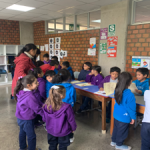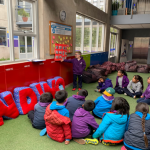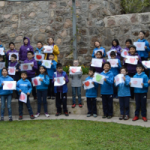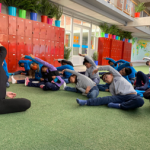Encouraging students to show agency throughout the inquiry process
by Fabricio Miranda, Andino Cusco International School, Peru.
Our third-grade students engaged in an interactive triggering activity, an auction role-play where they observed different objects for sale.
I presented objects such as pencils, notebooks, candies, chewing gum, and fruit and, at the end of the auction, students answered the following questions:
-
-
-
-
- Why did you decide to buy that object?
- Was it a good decision?
- Why?
-
-
-
Students then completed a thinking routine, writing their ideas and questions for the unit. That was how our unit of inquiry began – with the transdisciplinary theme “Who we are” and the central idea: “The decisions we make affect our well-being”.
An important objective was to encourage student agency. Students were completely in charge of planning, designing and demonstrating their own learning – and action – actively participating in different learning experiences. One of these was to research the concept of “decision” and students shared their inquiries in groups by using the ‘museum’ technique.
After reading a book on decision-making, students connected the story to their daily lives; on the moments they had to make a decision and reflect whether the decision was easy or difficult to make. Students then connected our unit of inquiry to one of the IB attributes; they chose “balanced” which the IB defines as “We understand the importance of balancing different aspects of our lives—intellectual, physical, and emotional—to achieve well-being for ourselves and others. We recognize our interdependence with other people and with the world in which we live.” (IB learner profile, 2017). They understood that making decisions can affect their bodies, feelings and emotions, and well-being, so they decided to take actions that demonstrate “agency” including:
- Creating healthy menus
- Brainstorming a list of healthy habits.
- Developing an action plan to make good decisions at school and at home. (This was a great opportunity for parents and children to work together).
- Creating a plan for healthy eating habits for a week.
- Putting into practice everything they wrote in their journals.
- Identifying and reflecting on situations in which they had to make decisions.
I enjoyed observing my students engage in these different learning experiences, such as:
- sorting information about healthy habits, food pyramid, and well-being
- using graphic organizers to show their understanding of the information they gathered
- writing paragraphs about their favorite foods
- participating in different speaking activities, sharing about the foods they liked and disliked as well as the activities they practice at home to stay healthy
- singing a song and reciting a poem – they also recorded their presentation to share it on our social media platforms so that our learning community could put into practice the IB attribute “balanced”.(Blog)
- inviting a teacher to practice mindfulness with them and brainstorming ideas about how to keeping spiritually healthy and respect all the different perspectives including religion, soft music, Yoga, etc.
As a final action, my students decided to invite students from Kindergarten to Fourth grade to share their final portfolio – including all the learning evidence they had collected throughout the inquiry process.
 They assessed themselves as a group and as individuals.
They assessed themselves as a group and as individuals.
They reflected on their learning and wrote their reflections in their journals.
From a teacher perspective, I noticed that our students developed positive attitudes towards making decisions, understanding that every choice affects our well-being. Thanks to the experiences in this unit of inquiry, they expressed feeling comfortable when demonstrating to their community that they can be balanced and take initiative, express their interests and be aware of their own learning goals. They showed agency throughout the entire learning process.
References
RAMOS VALDIVIEZO MARIA MILAGROS, “Aplicación de la técnica del museo para mejorar la planificación de la sesión de aprendizaje de las docentes de la i.e.i. n° 64 -callao”. Universidad Peruana Cayetano Heredia, 2017. Web May 29, 2019. “Definición de la técnica del museo” http://repositorio.upch.edu.pe/bitstream/handle/upch/3936/Aplicacion_RamosValdiviezo_Maria.pdf?sequence=1&isAllowed=y
International Baccalaureate Organization (2013) IB Learner profile. Recovered from: https://www.ibo.org/contentassets/fd82f70643ef4086b7d3f292cc214962/learner-profile-en.pdf
Fabricio Miranda, PYP English Teacher and Early Years-Primary English Coordinator at Andino Cusco International School in Peru is passionate about helping students to learn by constructing significant and relevant concepts through inquiring and collaborative work. After moving from Trujillo to Cusco because he wanted to work in an IB World School, Fabricio joined Andino in 2017 where he is pursuing his dream to let more people know about an IB education.





No comments yet.